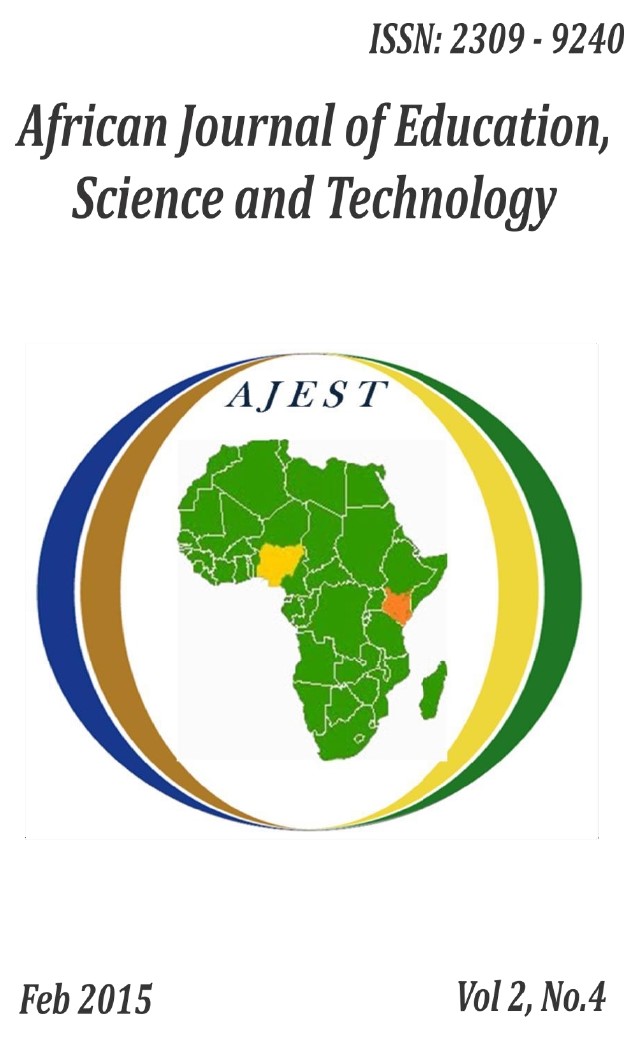Modeling Growth and Yield of Grevillea robusta Grown on Farm Boundary in Nandi County, Kenya
##article.abstract##
Population pressure has led to changes in land use and livelihood strategies in most highlands of Kenya. This among other factors has contributed to the increased integration of fast growing exotic trees species in to tree-crop production systems on short rotation for socio-economic benefits. Grevillea robusta is one of the exotic species in Kenya which is planted along farm boundaries for fuel wood and timber production. It is normally grown at varied linear spacing and different levels of management. It is preferred by most farmers because of its fast growth and yield as well as its suitability to be integrated with crops. This study investigated growth and yield of Grevillea trees grown in line configuration boundary planting and their economic implication in Nandi County. Farmers growing Grevillea who knew its ages were identified and growth data (height, diameter at breast height-dbh) collected from willing farmers. A total of 985 trees of Grevillea of ages ranging from 1-15 years in 39 different locations within the Upper and lower highland agro-ecological zone in Nandi County were measured. Six independent variables, that is; height, dbh, basal area (BA), age, location and spacing were used in modelling. The results revealed significant differences among the trees for height (P=0.0001), basal area (P=0.0001) and location (P=0.0001). Spacing was not significant (P=0.1993). Height was modeled using the equation Height= -22.1003 + 25.0071 *(Age^0.1566) while dbh was modeled using the equation DBH = -4.4506 + 7.2629 *(Age^0.5971) for growth while volume was modeled using the equation V=D²H. Results of the socio-economic role of boundary planted Grevillea showed that these trees contributed significantly in reducing the gap between supply and demand for wood products in the study area. This study did not find overwhelming evidence (p>0.05) in support of different linear spacing distances thus calling for further research
References
3.08 conference. Galway-Mayo Institute of Technology, Galway Ireland, 18-23 June 2006.
Imo, M., Ogweno, D. O., Matano, A., & Orinda, B. (2001). Adoption of agro-forestry and improved land use practices in Kipkaren river catchment, Kenya. 1st National Scientific Conference, Lake Victoria Environmental Management Project, Kisumu, Kenya. 15th - 19th October, 2001.
Jaetzold, R., Schmidt, H. (1983). Farm Management Handbook of Kenya. Part B: Rift Valley and Central Provinces. Ministry of Agriculture, Republic of Kenya, Nairobi, Kenya.
Kenya National Bureau of Statistics (KNBS) - Ministry of Planning, National Development and Vision 2030, 2009 Report.
Kirongo, B. B., Christine, K., & Kimani, G. K. (2013). The effects of intra-specific competition on survival in a Casuarina Equisetifolia spacing trial in Gede, Malindi, Kenya, 4(7), 293–298.
Kirongo, B. (1996). Effects of Non-crop Vegetation Management on growth and productivity of young radiate pine. MSc. Thesis, University of Canterbury (Christchurch, New Zealand). Pp. 152.
Kirongo, B. (2000). Modelling growth responses of juvenile radiate pine (pinus radiate D. Don) clones subjected to different weed competition levels in Canterbury, New Zealand. Ph.D. Thesis, University of Canterbury (Christchurch, New Zealand). pp. 28-35.
Kirongo, B., Mbelase, A., Senelwa, K., Hitimana, J., & Etiegni, L. (2012). Spacing and Genotype on Height and Diameter growth of four Eucalyptus under short rottion. Journal of Tropical Forest Management (Manajemen Hutan Tropika) XVIII (1), 1-9
Matano, A.S., & Ogweno., D.O. (2003). Potentials for farm forestry in the Lake Victoria Basin, Kenya. Case study for North Nandi.
Muchiri, M.N., Miina, J., & Pukkala, T. (2002). Modelling trees‘ effect on Maize in the Grevillea robusta + Maize System in Central Kenya. Agroforestry Systems 55, 113-123
Ngugi, A.W., & Brabley, P. N. (1986). Agroforestry, Soil Conservation and Wood fuel in Murang'a District.
Nairobi. The Beijer Institute.
Ogweno, D.O., M. Imo, A. Matano, and B.Orinda, (2001). Evaluation of the management and sustainability of private tree nurseries in Kipkaren river catchment, Kenya. 1st National Scientific Conference, Lake Victoria Environmental Management Project, Kisumu, Kenya. 15th
- 19th October, 2001.
Okello, B.D., O‘Connor, T.G., & Young, T.P., (2001). Growth, biomass estimates, and charcoal production of Acacia drepanolobium in Laikipia, Kenya. Forest Ecol. Manage. 142, 143–153.
SAS/STATS. SAS Institute Inc. (2010). SAS/STAT TM 6.12
Shainsky, L.J., Newton, M., & Radosevish, S.R. (1992). Effects of intra- and inter-specific competition on root and shoot biomass of young D. fir and red alder. Canadian Journal of Forest Research 22, 101-110.


